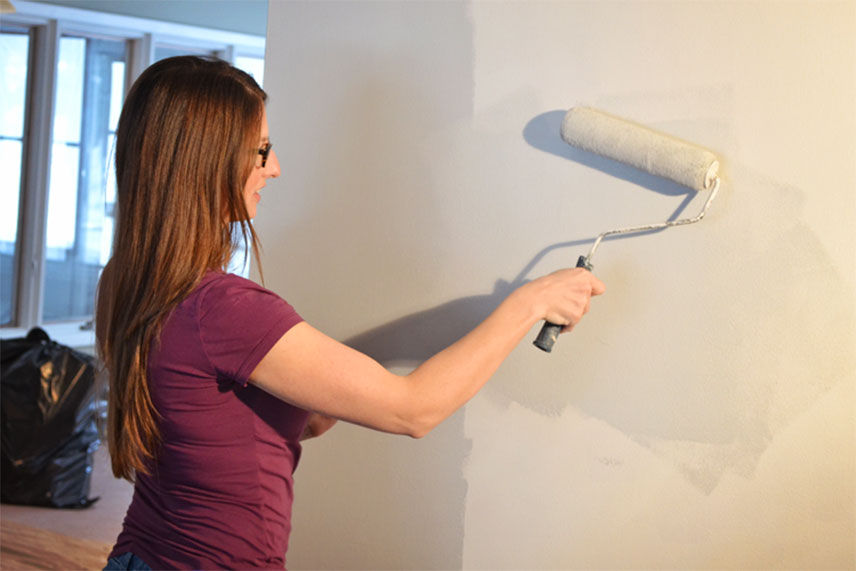Tips For Re-Using Your Painting Tools

If you're looking for ways to cut costs on your next painting project, consider re-using your paint tools!
Rollers and brushes can both be used multiple times with a little extra effort at the end of each project. Re-using painting tools will not only save you money, but tossing less rollers and brushes into our landfills will help lessen our environmental footprint too.
When you're done painting:
- Get as much leftover paint off of the brush as possible by rolling or brushing it on paper or cardboard. Old phone books work well for smaller brushes - really, any disposable surface is fine. The less paint left on your tool before beginning the cleaning process, the better!
- No time to clean? It is always best to clean your painting tools right away, but if you need to, you put can your wet brush or roller in a sealed bag and put it in the refrigerator over night. This will temporarily prevent the paint from drying, making it much easier to clean your painting tools tomorrow. That's right - tomorrow! Don't wait too long!
- There is no need to soak brushes or rollers in water for an extended period of time, even if your paint has started to dry. In fact, this could damage them and defeat the purpose of cleaning. Seal them or clean them right away. If they have dried paint on them, use the same cleaning process as wet paint, plus a little extra patience.
- Remember that latex paint requires completely different removal techniques than oil-based paint. Latex paints can generally be cleaned just using warm water, adding a little dish detergent if necessary. Oil-based paint must be removed with a solvent like paint thinner, or one of the many eco-friendly solvent alternatives available. It is also important to note that anything with solvent on it (steel wool, paint brushes, paper, etc.) could be flammable and should be disposed of accordingly.
- After cleaning your painting tool, be sure to let it dry completely before starting your next project! Wet brushes and rollers will dilute latex paint and repel oil-based paint, which could impact your paint color and application.
For brushes:
- To remove latex paint from a paintbrush, fill a container with warm water and use the brush to 'paint' (by applying brush strokes) the bottom of the container to remove more leftover paint. You may need to dump the water out and repeat this step several times. If your paint has started to dry a little, you may need to add some detergent to the water like dish soap or shampoo.
- To remove oil based paint, consult the original paint can/container to see what type of solvent is needed for that paint. Most household paints and varnishes can be cleaned up with mineral spirits, or a similar eco-friendly solvent alternative. Pour the solvent into a container and dip the paint brush into the solvent. Work the paint thinner through the brush bristles, dipping up and down in the container several times. Spin the paint brush into a waste area to remove excess thinner and then repeat the process with a clean container and clean thinner.
- When you have gotten most of the paint out, switch to a running water source and rinse the brush while lightly separating the bristles for an extra clean brush.
- Shake the brush dry (or invest in a spinner if you plan to paint often) and re-shape the bristles with your hands or a brush comb.
- Lay the brush flat or hang it upside down to dry. Store it the same way. Never store a paint brush standing on it's bristles!
For rollers:
- To remove latex paint from a paint roller, wash it with warm water, adding detergent if needed and rinse until clean. Repeat the process if necessary. Always use a clean container with clean soapy water and follow with a clear water rinse. If needed, use a putty knife to help scrape off the paint.
- To remove oil-based paint from a roller, pour the solvent into a container and dip the roller cover into the solvent. Repeat this process using a clean container and fresh solvent until the roller cover is clean. We strongly suggest wearing gloves!
- Dry and store your roller covers with care. String roller covers on rope or dowels to aid in drying the sleeves. Don't stand the paint roller on its end or lay it on its nap. Dry thoroughly before storing in dust-free cabinets or boxes.
Need help?
If you're still feeling unsure of how to clean your painting tools, visit your local Valu Home Center and speak to one of our knowledgeable Associates! They'll help you choose the best tool for the job, and show you options for your cleaning process.